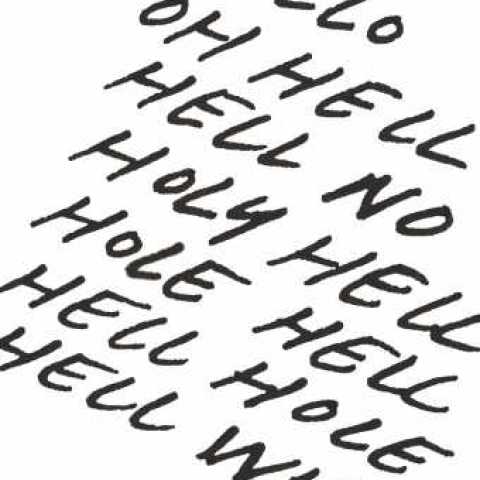
Opening Tuesday 3rd July, 6:30 - 8:30 pm
Show runs 4th July - 16th September 2018
by appointment only (closed throughout August)
Writing is primarily concerned with creating an opening where the writing subject endlessly disappears. 1
For his exhibition at Lily Brooke, Charlie Godet Thomas continues to explore visual poetry and the bridge between writing, the autobiographical, the tragic and the humorous. Mounted on one wall we are presented with a rotating disc, Ongoing Poem (The Clock at the Sailors Arms), which takes part of its title from Dylan Thomas's Under Milk Wood.
The ship' s clock in the bar says half past eleven. Half past eleven is opening time. The hands of the clock have stayed still at half past eleven for fifty years. It' s always opening time in the Sailors Arms. 2
A sense of time stopping still is a recurring motif in Thomas' s work. In Ongoing Poem (The Clock at the Sailors Arms) that stillness, paradoxically, takes the form of a seemingly infinite motorised loop. The work is a further investigation into the potential of circular structural forms in poetry, which Thomas has explored increasingly in his recent work. In this instance the copy editing symbol meaning 'run on', is animated as a means of allowing the otherwise mute diagrammatic character to perform itself, encouraging us to pause, whilst our minds are running on, running on, running on (&c).
Alongside this work is Songs of Experience, a shelf-like structure which Thomas describe s as a means by which he is able to place three "written" works purposefully "on" the "page" of the exhibition space, a meeting of the flatness of written poetry and the dimensional potentials of sculpture. These works represent a new approach to his series Illuminated Manuscripts, which fuse the stylistic qualities of both newspaper cartoon strips and the archaic form of the illuminated manuscript, which are, notably, ancient and more recent means by which writing and imagery have been amalgamated. In this instance, the title of the work refers to William Blake's collection of illustrated print-poems Songs of Innocence and Experience, summoning to fore the Blakean existential-mythic state of "paradise" and "fall", all be it re-imagined for the world we find ourselves in, in 2018. In Songs of Experience, there is a tangible sense of a place under close observation, the passages seemingly serve to discover in the analysis of the small individual moment the crystal of the total event. 3
The notions of flow and punctuation, as well as those of positive and negative space also play a central role in the work. These ideas are exemplified in the Marginalia series, in which Thomas repurposes offcuts from the making of Song of Experience, elevating the potentially overlooked fragments by arranging them amongst the starkness of a sculptural "blank page". They could be considered as painterly poems which investigate the importance of negative space as it is dealt with in more conventional poetic approaches, or perhaps more simply, a testament to looking closely at what is around us so as not to automatically discard what we might think of as worthless or superfluous.
______________________________________
1
Michel Foucault, "What is an Author?" (1969), in Language, Counter-memory, Practice: Selected Essays and Interviews, ed. Donald F. Bouchard (Ithaca, NY: Cornell University Press, 1977), p.116.
2
Dylan Thomas, Under Milk Wood (Weidenfeld & Nicolson, London, 2014) p. 14.
3
Walter Benjamin, The Arcades Project, trans. Howard Eiland and Kevin McLaughlin (Cambridge, MA: Harvard University Press, 1999) p.461.
For more information:
Lily Brooke
3 Ada Road,
London
SE5 7RW
